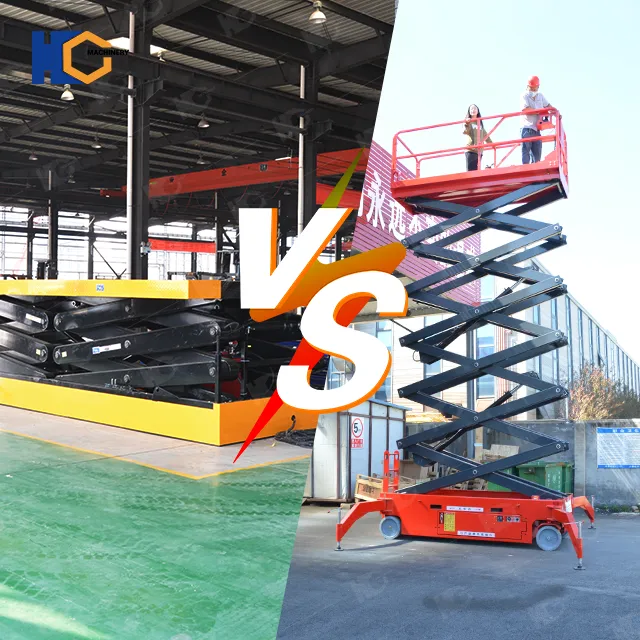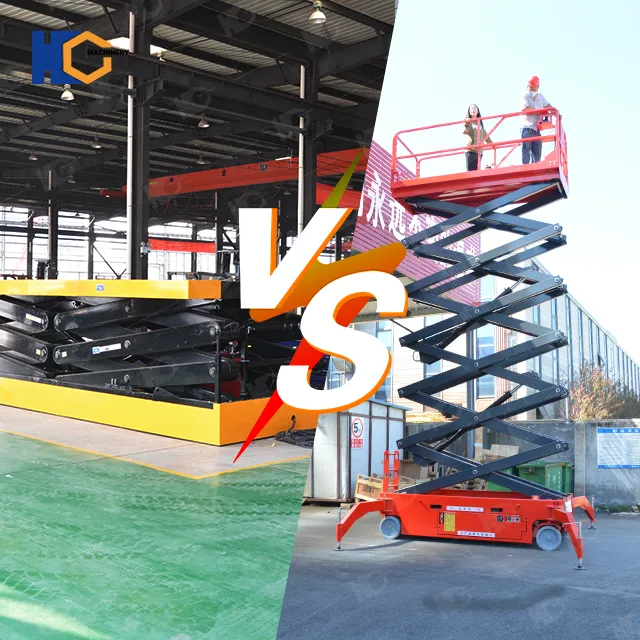Scissor lifts have revolutionized elevated work platforms, delivering unmatched safety and efficiency for tasks ranging from warehouse maintenance to construction projects. These versatile machines eliminate the risks of ladders and scaffolding while providing stable, adjustable work platforms. However, the critical choice between stationary and self-propelled models often leaves buyers grappling with a fundamental tradeoff: mobility versus stability.
The core distinction lies in their movement capabilities. Stationary scissor lifts are fixed-position workhorses, requiring forklifts or manual effort to relocate. They excel in predictable, long-duration tasks where platform stability is paramount - think assembly line support or dedicated maintenance stations. In contrast, self-propelled units integrate drive systems (electric or diesel) for autonomous movement, transforming workflow efficiency in dynamic environments like distribution centers or multi-site construction projects. This mobility comes at a premium, both in initial cost and operational complexity.
Decision-makers face three key pain points:
Cost Balance: While stationary lifts offer lower upfront prices (typically
5,000−20,000), hidden expenses like forklift rental for repositioning may erode savings. Self-propelled models (20,000−50,000+) justify their price through labor reduction but demand higher maintenance.
Efficiency Tradeoffs: A food processing plant might prefer stationary lifts for fixed sanitation points, whereas an Amazon fulfillment center would prioritize self-propelled units to adapt to real-time inventory shifts.
Scenario Alignment: Rough terrain favors tracked self-propelled lifts, but vibration-sensitive semiconductor installations demand stationary models' absolute stability.
This guide dissects these dilemmas through real-world operational metrics, helping you match lift capabilities to your workflow's rhythm rather than defaulting to conventional choices.
*(Key Price Reference: Stationary scissor lifts: 5,000(basic) to 5,000(basic)to20,000 (heavy-duty) Self-propelled scissor lifts: 20,000(standard) to 20,000(standard)to50,000+ (high-capacity/smart models) All prices reflect USD market averages for commercial-grade equipment.*)

Key Parameter Comparisons
| Parameter | Stationary Scissor Lift | Self-Propelled Scissor Lift |
|---|---|---|
| Mobility | Requires forklift/manual relocation | Electric/diesel-powered autonomous drive |
| Load Capacity | Higher (1.5+ tons) | Slightly lower (0.5-1 ton)* |
| Terrain Adaptability | Level, solid surfaces only | Mild uneven terrain (track options available) |
| Operational Efficiency | Ideal for fixed-position tasks | 60%+ time savings in multi-location work** |
| Price Range (USD) | 5,000−15,000 | 20,000−50,000+ (smart models) |
Footnotes:
*Reduced capacity due to added drive system components
**Based on 2023 MHI warehouse logistics study
Critical Observations:
Tradeoff Hierarchy: The 3:1 price ratio reflects the automation premium for self-propelled units, while stationary models dominate in pure load-bearing applications.
Hidden Cost Factors:
Stationary: Add 75−150/hour for forklift-assisted moves
Self-Propelled: 15-20% higher maintenance costs (drive train servicing)
Innovation Trends: New hybrid models now offer detachable drive systems (converting stationary to mobile as needed).
Scenario-Based Analysis: Matching Lift Types to Operational Needs
1. Warehouse Logistics: Path Optimization with Self-Propelled Lifts
In large-scale distribution centers (e.g., Amazon fulfillment warehouses), self-propelled scissor lifts deliver transformative efficiency. Their autonomous mobility allows:
Dynamic Reconfiguration: Real-time adaptation to inventory layout changes without manual repositioning.
Labor Savings: A single operator can manage multiple aisles, reducing staffing needs by ~40% (MHI 2023 data).
Precision Positioning: Laser-guided models achieve ±2cm alignment for narrow-aisle racking.
Tradeoff: Higher upfront cost (35k−50k) is offset by 12-18 month ROI in high-throughput facilities.
2. Production Line Maintenance: Stationary Lift Stability
Automotive assembly plants exemplify stationary scissor lifts' dominance for fixed-point tasks:
Vibration Resistance: Zero drivetrain movement ensures <0.1mm platform shake during precision tooling adjustments.
Heavy-Duty Performance: 2+ ton capacity supports robotic arm installations that would overload mobile units.
Safety Compliance: Locked position eliminates OSHA 1926.452(w) "unintended movement" risks.
Case Study: Ford's Kentucky plant reduced assembly line downtime by 27% after replacing mobile lifts with stationary units at 12 critical workstations.
3. Construction Sites: Multi-Level Agility
For high-rise projects, self-propelled lifts with rough-terrain packages provide:
Floor-to-Floor Transition: Turntable designs enable 90° aisle turns in stairwells (saving 15min/relocation).
Adaptive Surfaces: Pneumatic tires or tracks handle unfinished floors with 5° slope tolerance.
Tool Transport: Integrated cargo decks (200kg+) reduce secondary material lifts.
Limitation: Diesel models remain preferable for outdoor sites due to battery runtime constraints (<6hr in cold weather).
Emerging Hybrid Applications
Pharmaceutical Facilities: Stationary lifts with cleanroom packages (ISO Class 5) for sterile environments.
Retail Spaces: Compact self-propelled lifts (1m platform width) for nighttime shelf stocking in confined aisles.
Decision Matrix:
| Scenario | Recommended Type | Key Metric |
|---|---|---|
| Warehouse Inventory Management | Self-Propelled | >10 relocations/shift |
| Aircraft Assembly | Stationary | Vibration <0.05g RMS |
| Urban Construction | Tracked Self-Propelled | 800mm minimum aisle clearance |
Pro Tip: For mixed-use facilities, consider leasing a mobile unit for peak periods while maintaining stationary bases for routine tasks.
Hidden Costs & Long-Term Considerations
Stationary Scissor Lifts: The Relocation Burden
While stationary models have lower upfront costs (5,000–20,000), they incur significant hidden expenses:
Forklift Dependency: Requires 75–150/hour rental fees (or dedicated equipment) for repositioning.
Labor Inefficiency: Workers spend 15–30 minutes per move for realignment and safety checks.
Floor Space Costs: Fixed positions may force suboptimal workstation layouts, increasing travel distances.
Example: A mid-sized warehouse with 10 daily relocations could spend $45,000/year on forklift operations alone.
Self-Propelled Lifts: The Automation Premium
Self-propelled units (20,000–50,000+) shift costs from labor to maintenance:
Drive System Upkeep: Annual 1,200–3,000 for motor/transmission servicing (vs. $500 for stationary hydraulics).
Energy Costs:
Electric: 800–1,500 per battery (3–5 year lifespan)
Diesel: 0.30–0.50/hour in fuel (continuous operation)
Training Investments: OSHA-compliant operator certification adds
250–500/employee.
Tradeoff: A $35,000 self-propelled lift typically breaks even in 2–3 years versus stationary models in high-mobility workflows.
Total Cost of Ownership (TCO) Comparison
| Cost Factor | Stationary (5 Years) | Self-Propelled (5 Years) |
|---|---|---|
| Acquisition | $15,000 | $35,000 |
| Relocation/Maintenance | $60,000 | $18,000 |
| Energy/Consumables | $2,500 | $7,500 |
| Total | $77,500 | $60,500 |
Data assumes: 2,000 annual operating hours, 3 moves/day for stationary lifts
Key Insight: Self-propelled models win long-term in high-frequency relocation scenarios, while stationary lifts suit low-mobility, high-load applications.
Pro Tip: Negotiate battery leasing programs with manufacturers to mitigate replacement costs for electric models.
Safety & Compliance Considerations
Stationary Scissor Lifts: Stability First
Anti-Settlement Locks: Critical for preventing unintended lowering due to hydraulic leaks or pressure loss (ANSI/SAIA A92.20-2021 Standard).
Load Sensors: Mandatory on models >1 ton to prevent overloading (OSHA 1926.451(b)(10)).
Fall Protection: Requires guardrails (42” height) and toe-boards for stationary platforms.
Risk Factor: 18% of stationary lift incidents involve improper locking before ascent (BLS 2022 data).
Self-Propelled Lifts: Dynamic Hazards
Collision Avoidance: ANSI A92.20 requires:
Proximity Sensors (3m detection range)
Emergency Stop (<0.5s response time)
Slope Operation: Limited to 5° incline unless equipped with tilt alarms (OSHA 1926.451(c)(5)).
Operator Training: Mandatory certification for drive systems (8-hour minimum per ANSI).
Emerging Tech: 2024 models now integrate AI obstacle mapping to meet updated ISO 3691-4 standards.
Compliance Checklist
| Requirement | Stationary | Self-Propelled |
|---|---|---|
| Pre-Use Inspection | Hydraulic leak test | Drive system diagnostic |
| Annual Certification | Load plate verification | Sensor calibration |
| Accident Triggers | Missing lock pins | Unauthorized speed override |
Critical Reminder: Stationary lifts require weekly lock mechanism tests, while self-propelled units need daily brake checks per manufacturer specs.
Scissor Lift Selection Guide
Choosing between stationary and self-propelled scissor lifts depends on workflow demands, budget constraints, and long-term operational efficiency. Below is a structured decision-making guide to help you select the right equipment for your needs.
When to Choose a STATIONARY Scissor Lift
✓ Single, Fixed Work Location
Ideal for assembly lines, maintenance stations, or production areas where the lift remains in one position long-term.
Eliminates the need for repositioning, reducing downtime.
✓ Budget Constraints (Lower Upfront Cost)
5,000–20,000 initial investment vs. 20,000–50,000+ for self-propelled models.
Lower maintenance costs (no drive system to service).
✓ Heavy-Duty Load Requirements (>1 Ton)
Better stability for heavy equipment installation (e.g., industrial machinery, HVAC systems).
No drive system means higher weight capacity for the same platform size.
Best Applications:
✔ Automotive assembly plants
✔ Fixed warehouse picking stations
✔ Long-term construction site support
When to Choose a SELF-PROPELLED Scissor Lift
✓ Frequent Relocations (5+ Moves/Day)
Saves 60%+ time compared to manual/forklift-assisted moves.
Justifies higher initial cost through labor efficiency.
✓ Complex or Confined Work Environments
Narrow aisles, multi-floor access, or obstacle-rich sites benefit from autonomous mobility.
Some models feature 360° rotation or zero-turn radius for tight spaces.
✓ High Labor Costs Outweigh Equipment Price Difference
If forklift rentals or manual labor costs exceed $20,000/year, self-propelled lifts offer a faster ROI.
Reduces dependency on additional equipment (no need for a separate forklift).
Best Applications:
✔ Large warehouses & distribution centers
✔ Multi-level construction projects
✔ Retail stores with frequent layout changes
Hybrid Solutions?
Some manufacturers offer convertible models (stationary base + optional drive kits), providing flexibility for evolving needs. However, these typically cost 10–20% more than dedicated units.
Final Recommendation:
| Factor | Stationary Wins | Self-Propelled Wins |
|---|---|---|
| Cost Sensitivity | ✔ Lower upfront cost | ❌ Higher investment |
| Mobility Needs | ❌ Manual moves needed | ✔ Autonomous operation |
| Load Capacity | ✔ 1.5+ tons | ❌ Typically 0.5–1 ton |
| Maintenance | ✔ Simple hydraulics | ❌ Drive system upkeep |
Still unsure? Rent each type for a week to compare real-world performance in your facility.
Future Trends in Scissor Lift Technology
Self-Propelled Lifts: Smarter & More Efficient
Autonomous Navigation: LiDAR and AI-powered obstacle detection enable fully automated repositioning (already in pilot use at Tesla warehouses).
Hybrid Power Systems: Electric-diesel combos provide 8+ hours of runtime with emergency backup for critical operations.
Predictive Maintenance: IoT sensors alert operators to motor wear or hydraulic leaks before failures occur.
Stationary Lifts: Modular & Adaptive
Quick-Deploy Kits: Bolt-together designs allow 24-hour assembly/disassembly for temporary production lines.
Smart Load Monitoring: Wireless load cells send real-time weight data to facility control systems.
Energy Recovery: Regenerative hydraulics cut power consumption by 15-20% in high-cycle applications.
Market Shift: By 2027, 35% of new self-propelled lifts will feature autonomous capabilities (Interact Analysis forecast), while stationary models dominate heavy-industry customization.
Coming Soon: Hydrogen fuel cell prototypes (2025-26) may disrupt current power paradigms.
Conclusion
The choice between self-propelled and stationary scissor lifts ultimately boils down to prioritizing movement flexibility or cost-effective stability. While self-propelled models excel in dynamic environments, stationary lifts remain unbeatable for heavy-duty, fixed-location tasks. Don’t base decisions on upfront price alone—calculate 3-year Total Cost of Ownership (TCO), factoring in labor, maintenance, and efficiency gains. Test both types in your workflow before committing. The right lift isn’t just about specs—it’s about matching technology to your operational rhythm.

920.webp)
606.webp)
235.webp)